Managing Sports Facilities: A Report on YMCA Operations and Strategies
VerifiedAdded on 2021/01/01
|10
|2676
|427
Report
AI Summary
This report provides a comprehensive analysis of managing YMCA sports facilities. It begins with an introduction to sports and recreation, highlighting the YMCA's role in promoting physical activity and community engagement across Australia. The main body of the report details the organizational structure of the YMCA, including its various departments and the range of recreational activities offered. It explores the functions of sports facilities, such as enhancing relationships, reducing crime rates, attracting tourism, and reducing stress. The report also identifies the risks involved in managing sports facilities, including financial threats and the impact of weather changes, and discusses recent trends such as the use of social media for connecting with members and promoting activities. Furthermore, the report outlines the processes required to manage, plan, and operate a sporting facility, including demand assessment, feasibility studies, design phases, and capital funding. It examines the impact of social media on sports, emphasizing its role in advertising services, establishing connectivity with followers, and promoting events. The report concludes by summarizing the key aspects of YMCA's sports and recreation centers, emphasizing their positive impact on community well-being and the use of technology in facility management.

MANAGING SPORTS FACILITIES
Paraphrase This Document
Need a fresh take? Get an instant paraphrase of this document with our AI Paraphraser
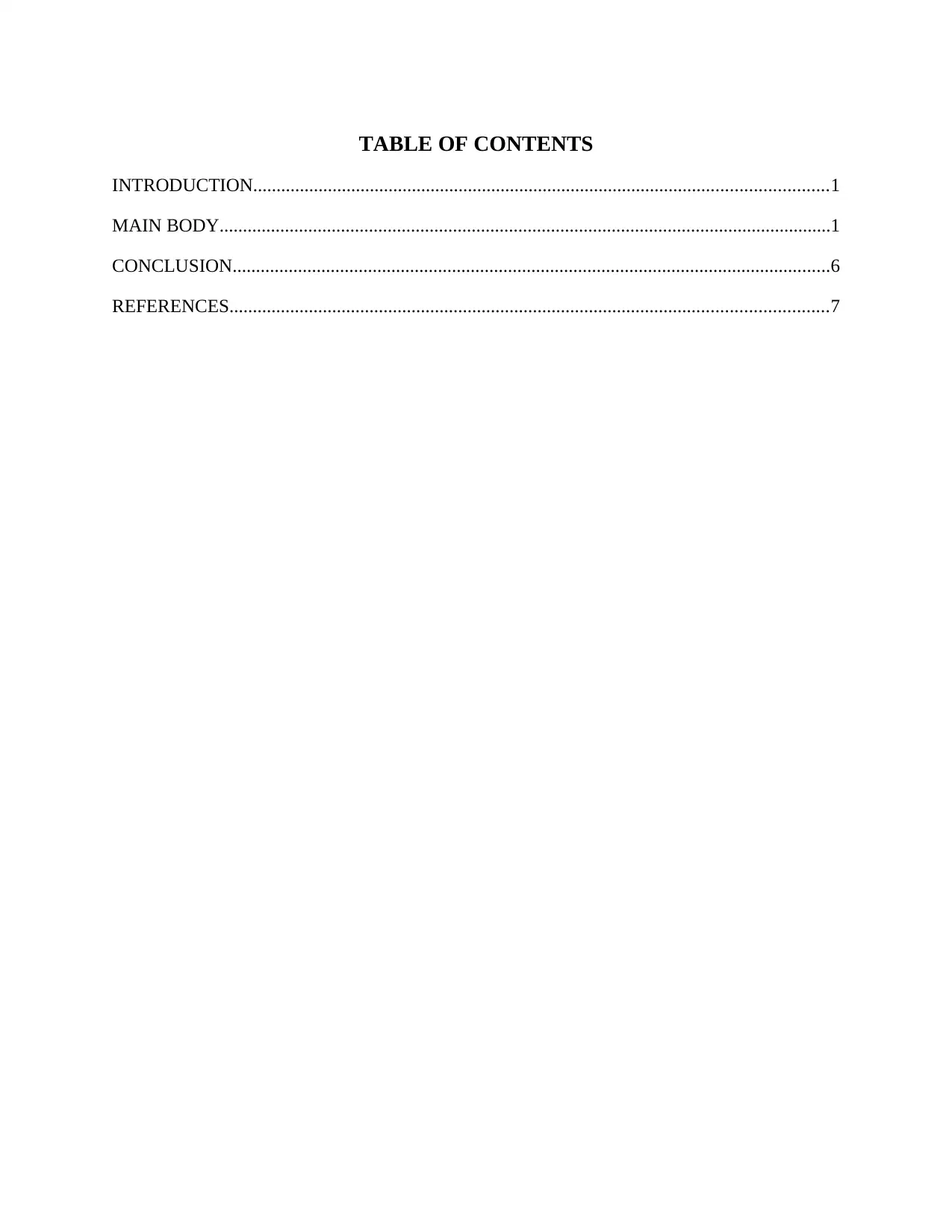
TABLE OF CONTENTS
INTRODUCTION...........................................................................................................................1
MAIN BODY...................................................................................................................................1
CONCLUSION................................................................................................................................6
REFERENCES................................................................................................................................7
INTRODUCTION...........................................................................................................................1
MAIN BODY...................................................................................................................................1
CONCLUSION................................................................................................................................6
REFERENCES................................................................................................................................7
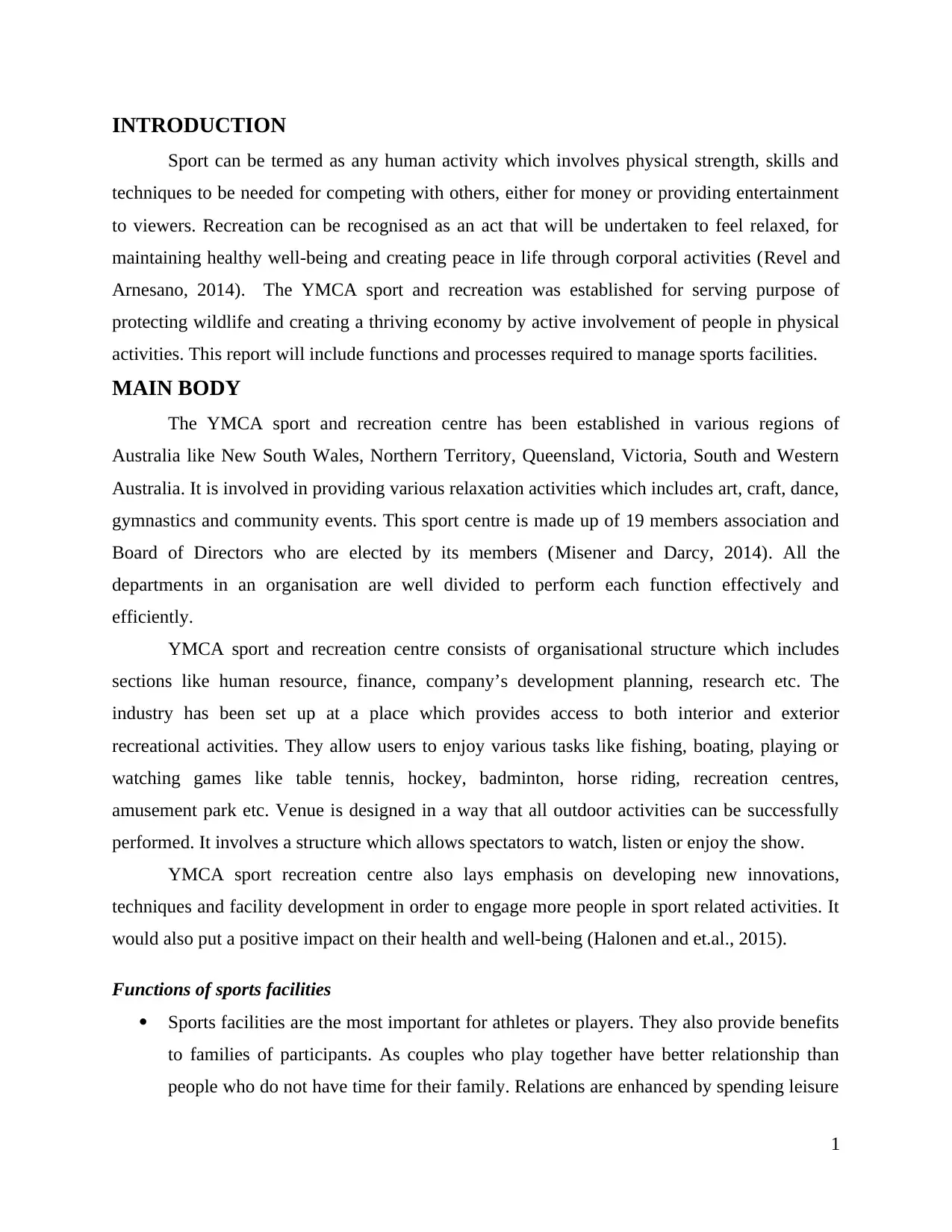
INTRODUCTION
Sport can be termed as any human activity which involves physical strength, skills and
techniques to be needed for competing with others, either for money or providing entertainment
to viewers. Recreation can be recognised as an act that will be undertaken to feel relaxed, for
maintaining healthy well-being and creating peace in life through corporal activities (Revel and
Arnesano, 2014). The YMCA sport and recreation was established for serving purpose of
protecting wildlife and creating a thriving economy by active involvement of people in physical
activities. This report will include functions and processes required to manage sports facilities.
MAIN BODY
The YMCA sport and recreation centre has been established in various regions of
Australia like New South Wales, Northern Territory, Queensland, Victoria, South and Western
Australia. It is involved in providing various relaxation activities which includes art, craft, dance,
gymnastics and community events. This sport centre is made up of 19 members association and
Board of Directors who are elected by its members (Misener and Darcy, 2014). All the
departments in an organisation are well divided to perform each function effectively and
efficiently.
YMCA sport and recreation centre consists of organisational structure which includes
sections like human resource, finance, company’s development planning, research etc. The
industry has been set up at a place which provides access to both interior and exterior
recreational activities. They allow users to enjoy various tasks like fishing, boating, playing or
watching games like table tennis, hockey, badminton, horse riding, recreation centres,
amusement park etc. Venue is designed in a way that all outdoor activities can be successfully
performed. It involves a structure which allows spectators to watch, listen or enjoy the show.
YMCA sport recreation centre also lays emphasis on developing new innovations,
techniques and facility development in order to engage more people in sport related activities. It
would also put a positive impact on their health and well-being (Halonen and et.al., 2015).
Functions of sports facilities
Sports facilities are the most important for athletes or players. They also provide benefits
to families of participants. As couples who play together have better relationship than
people who do not have time for their family. Relations are enhanced by spending leisure
1
Sport can be termed as any human activity which involves physical strength, skills and
techniques to be needed for competing with others, either for money or providing entertainment
to viewers. Recreation can be recognised as an act that will be undertaken to feel relaxed, for
maintaining healthy well-being and creating peace in life through corporal activities (Revel and
Arnesano, 2014). The YMCA sport and recreation was established for serving purpose of
protecting wildlife and creating a thriving economy by active involvement of people in physical
activities. This report will include functions and processes required to manage sports facilities.
MAIN BODY
The YMCA sport and recreation centre has been established in various regions of
Australia like New South Wales, Northern Territory, Queensland, Victoria, South and Western
Australia. It is involved in providing various relaxation activities which includes art, craft, dance,
gymnastics and community events. This sport centre is made up of 19 members association and
Board of Directors who are elected by its members (Misener and Darcy, 2014). All the
departments in an organisation are well divided to perform each function effectively and
efficiently.
YMCA sport and recreation centre consists of organisational structure which includes
sections like human resource, finance, company’s development planning, research etc. The
industry has been set up at a place which provides access to both interior and exterior
recreational activities. They allow users to enjoy various tasks like fishing, boating, playing or
watching games like table tennis, hockey, badminton, horse riding, recreation centres,
amusement park etc. Venue is designed in a way that all outdoor activities can be successfully
performed. It involves a structure which allows spectators to watch, listen or enjoy the show.
YMCA sport recreation centre also lays emphasis on developing new innovations,
techniques and facility development in order to engage more people in sport related activities. It
would also put a positive impact on their health and well-being (Halonen and et.al., 2015).
Functions of sports facilities
Sports facilities are the most important for athletes or players. They also provide benefits
to families of participants. As couples who play together have better relationship than
people who do not have time for their family. Relations are enhanced by spending leisure
1
⊘ This is a preview!⊘
Do you want full access?
Subscribe today to unlock all pages.

Trusted by 1+ million students worldwide
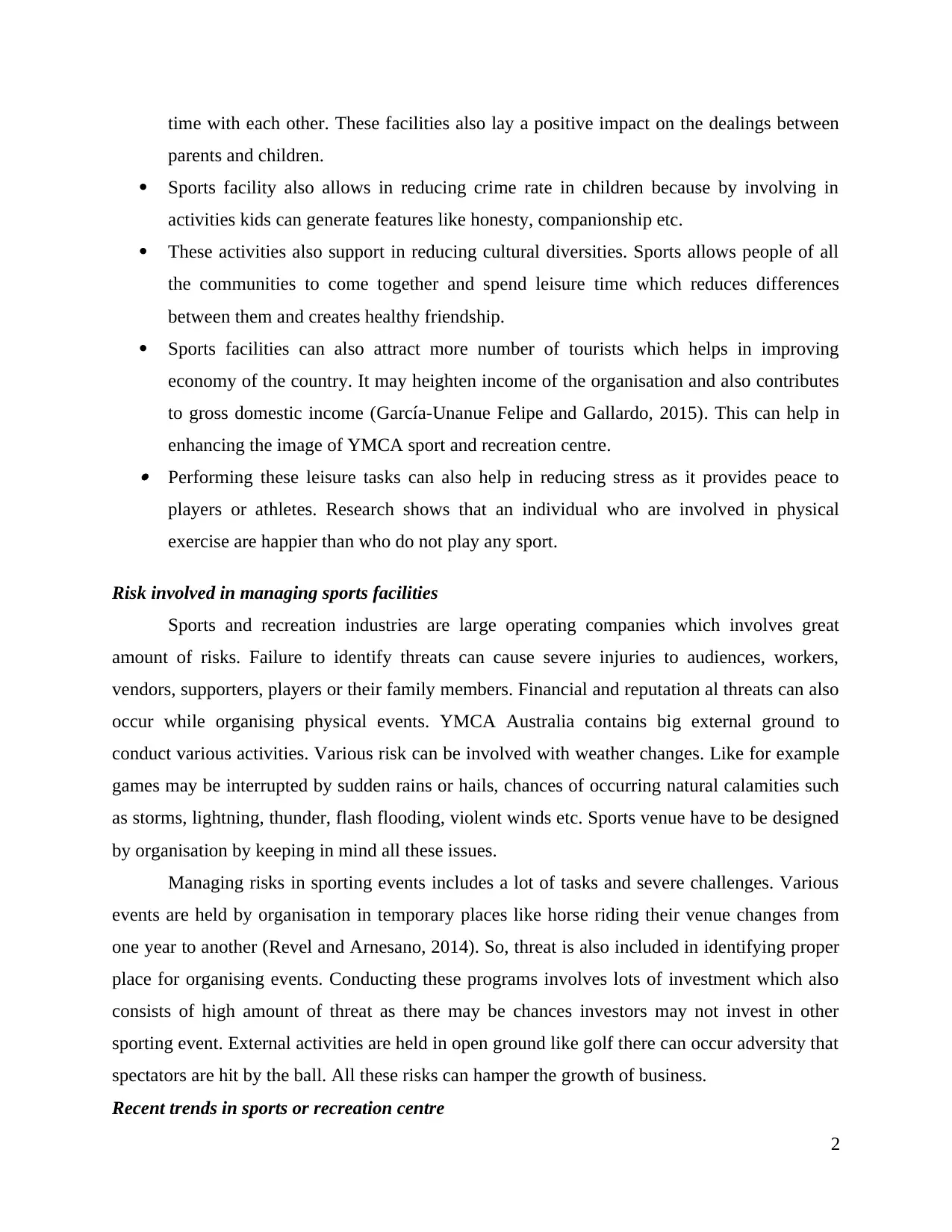
time with each other. These facilities also lay a positive impact on the dealings between
parents and children.
Sports facility also allows in reducing crime rate in children because by involving in
activities kids can generate features like honesty, companionship etc.
These activities also support in reducing cultural diversities. Sports allows people of all
the communities to come together and spend leisure time which reduces differences
between them and creates healthy friendship.
Sports facilities can also attract more number of tourists which helps in improving
economy of the country. It may heighten income of the organisation and also contributes
to gross domestic income (García-Unanue Felipe and Gallardo, 2015). This can help in
enhancing the image of YMCA sport and recreation centre. Performing these leisure tasks can also help in reducing stress as it provides peace to
players or athletes. Research shows that an individual who are involved in physical
exercise are happier than who do not play any sport.
Risk involved in managing sports facilities
Sports and recreation industries are large operating companies which involves great
amount of risks. Failure to identify threats can cause severe injuries to audiences, workers,
vendors, supporters, players or their family members. Financial and reputation al threats can also
occur while organising physical events. YMCA Australia contains big external ground to
conduct various activities. Various risk can be involved with weather changes. Like for example
games may be interrupted by sudden rains or hails, chances of occurring natural calamities such
as storms, lightning, thunder, flash flooding, violent winds etc. Sports venue have to be designed
by organisation by keeping in mind all these issues.
Managing risks in sporting events includes a lot of tasks and severe challenges. Various
events are held by organisation in temporary places like horse riding their venue changes from
one year to another (Revel and Arnesano, 2014). So, threat is also included in identifying proper
place for organising events. Conducting these programs involves lots of investment which also
consists of high amount of threat as there may be chances investors may not invest in other
sporting event. External activities are held in open ground like golf there can occur adversity that
spectators are hit by the ball. All these risks can hamper the growth of business.
Recent trends in sports or recreation centre
2
parents and children.
Sports facility also allows in reducing crime rate in children because by involving in
activities kids can generate features like honesty, companionship etc.
These activities also support in reducing cultural diversities. Sports allows people of all
the communities to come together and spend leisure time which reduces differences
between them and creates healthy friendship.
Sports facilities can also attract more number of tourists which helps in improving
economy of the country. It may heighten income of the organisation and also contributes
to gross domestic income (García-Unanue Felipe and Gallardo, 2015). This can help in
enhancing the image of YMCA sport and recreation centre. Performing these leisure tasks can also help in reducing stress as it provides peace to
players or athletes. Research shows that an individual who are involved in physical
exercise are happier than who do not play any sport.
Risk involved in managing sports facilities
Sports and recreation industries are large operating companies which involves great
amount of risks. Failure to identify threats can cause severe injuries to audiences, workers,
vendors, supporters, players or their family members. Financial and reputation al threats can also
occur while organising physical events. YMCA Australia contains big external ground to
conduct various activities. Various risk can be involved with weather changes. Like for example
games may be interrupted by sudden rains or hails, chances of occurring natural calamities such
as storms, lightning, thunder, flash flooding, violent winds etc. Sports venue have to be designed
by organisation by keeping in mind all these issues.
Managing risks in sporting events includes a lot of tasks and severe challenges. Various
events are held by organisation in temporary places like horse riding their venue changes from
one year to another (Revel and Arnesano, 2014). So, threat is also included in identifying proper
place for organising events. Conducting these programs involves lots of investment which also
consists of high amount of threat as there may be chances investors may not invest in other
sporting event. External activities are held in open ground like golf there can occur adversity that
spectators are hit by the ball. All these risks can hamper the growth of business.
Recent trends in sports or recreation centre
2
Paraphrase This Document
Need a fresh take? Get an instant paraphrase of this document with our AI Paraphraser
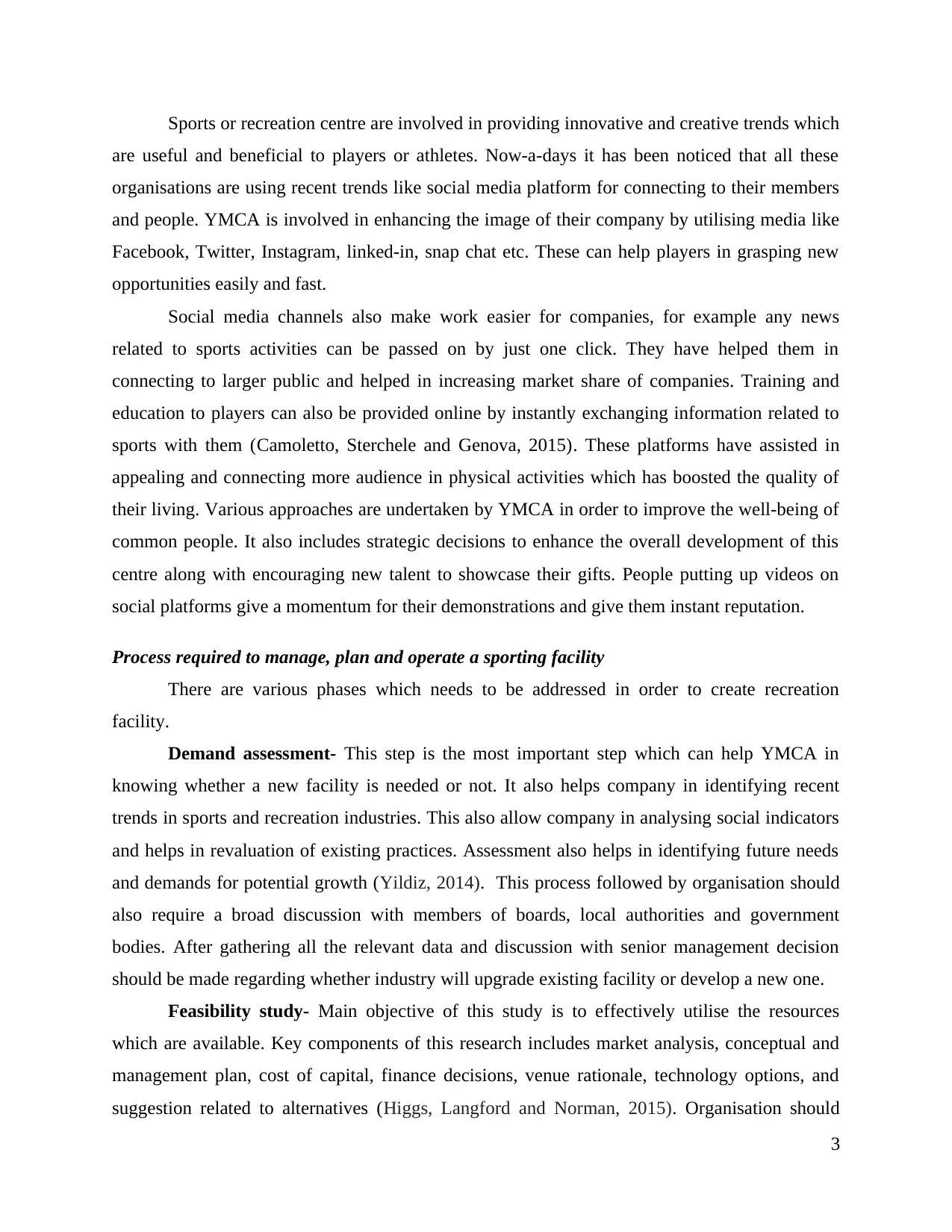
Sports or recreation centre are involved in providing innovative and creative trends which
are useful and beneficial to players or athletes. Now-a-days it has been noticed that all these
organisations are using recent trends like social media platform for connecting to their members
and people. YMCA is involved in enhancing the image of their company by utilising media like
Facebook, Twitter, Instagram, linked-in, snap chat etc. These can help players in grasping new
opportunities easily and fast.
Social media channels also make work easier for companies, for example any news
related to sports activities can be passed on by just one click. They have helped them in
connecting to larger public and helped in increasing market share of companies. Training and
education to players can also be provided online by instantly exchanging information related to
sports with them (Camoletto, Sterchele and Genova, 2015). These platforms have assisted in
appealing and connecting more audience in physical activities which has boosted the quality of
their living. Various approaches are undertaken by YMCA in order to improve the well-being of
common people. It also includes strategic decisions to enhance the overall development of this
centre along with encouraging new talent to showcase their gifts. People putting up videos on
social platforms give a momentum for their demonstrations and give them instant reputation.
Process required to manage, plan and operate a sporting facility
There are various phases which needs to be addressed in order to create recreation
facility.
Demand assessment- This step is the most important step which can help YMCA in
knowing whether a new facility is needed or not. It also helps company in identifying recent
trends in sports and recreation industries. This also allow company in analysing social indicators
and helps in revaluation of existing practices. Assessment also helps in identifying future needs
and demands for potential growth (Yildiz, 2014). This process followed by organisation should
also require a broad discussion with members of boards, local authorities and government
bodies. After gathering all the relevant data and discussion with senior management decision
should be made regarding whether industry will upgrade existing facility or develop a new one.
Feasibility study- Main objective of this study is to effectively utilise the resources
which are available. Key components of this research includes market analysis, conceptual and
management plan, cost of capital, finance decisions, venue rationale, technology options, and
suggestion related to alternatives (Higgs, Langford and Norman, 2015). Organisation should
3
are useful and beneficial to players or athletes. Now-a-days it has been noticed that all these
organisations are using recent trends like social media platform for connecting to their members
and people. YMCA is involved in enhancing the image of their company by utilising media like
Facebook, Twitter, Instagram, linked-in, snap chat etc. These can help players in grasping new
opportunities easily and fast.
Social media channels also make work easier for companies, for example any news
related to sports activities can be passed on by just one click. They have helped them in
connecting to larger public and helped in increasing market share of companies. Training and
education to players can also be provided online by instantly exchanging information related to
sports with them (Camoletto, Sterchele and Genova, 2015). These platforms have assisted in
appealing and connecting more audience in physical activities which has boosted the quality of
their living. Various approaches are undertaken by YMCA in order to improve the well-being of
common people. It also includes strategic decisions to enhance the overall development of this
centre along with encouraging new talent to showcase their gifts. People putting up videos on
social platforms give a momentum for their demonstrations and give them instant reputation.
Process required to manage, plan and operate a sporting facility
There are various phases which needs to be addressed in order to create recreation
facility.
Demand assessment- This step is the most important step which can help YMCA in
knowing whether a new facility is needed or not. It also helps company in identifying recent
trends in sports and recreation industries. This also allow company in analysing social indicators
and helps in revaluation of existing practices. Assessment also helps in identifying future needs
and demands for potential growth (Yildiz, 2014). This process followed by organisation should
also require a broad discussion with members of boards, local authorities and government
bodies. After gathering all the relevant data and discussion with senior management decision
should be made regarding whether industry will upgrade existing facility or develop a new one.
Feasibility study- Main objective of this study is to effectively utilise the resources
which are available. Key components of this research includes market analysis, conceptual and
management plan, cost of capital, finance decisions, venue rationale, technology options, and
suggestion related to alternatives (Higgs, Langford and Norman, 2015). Organisation should
3
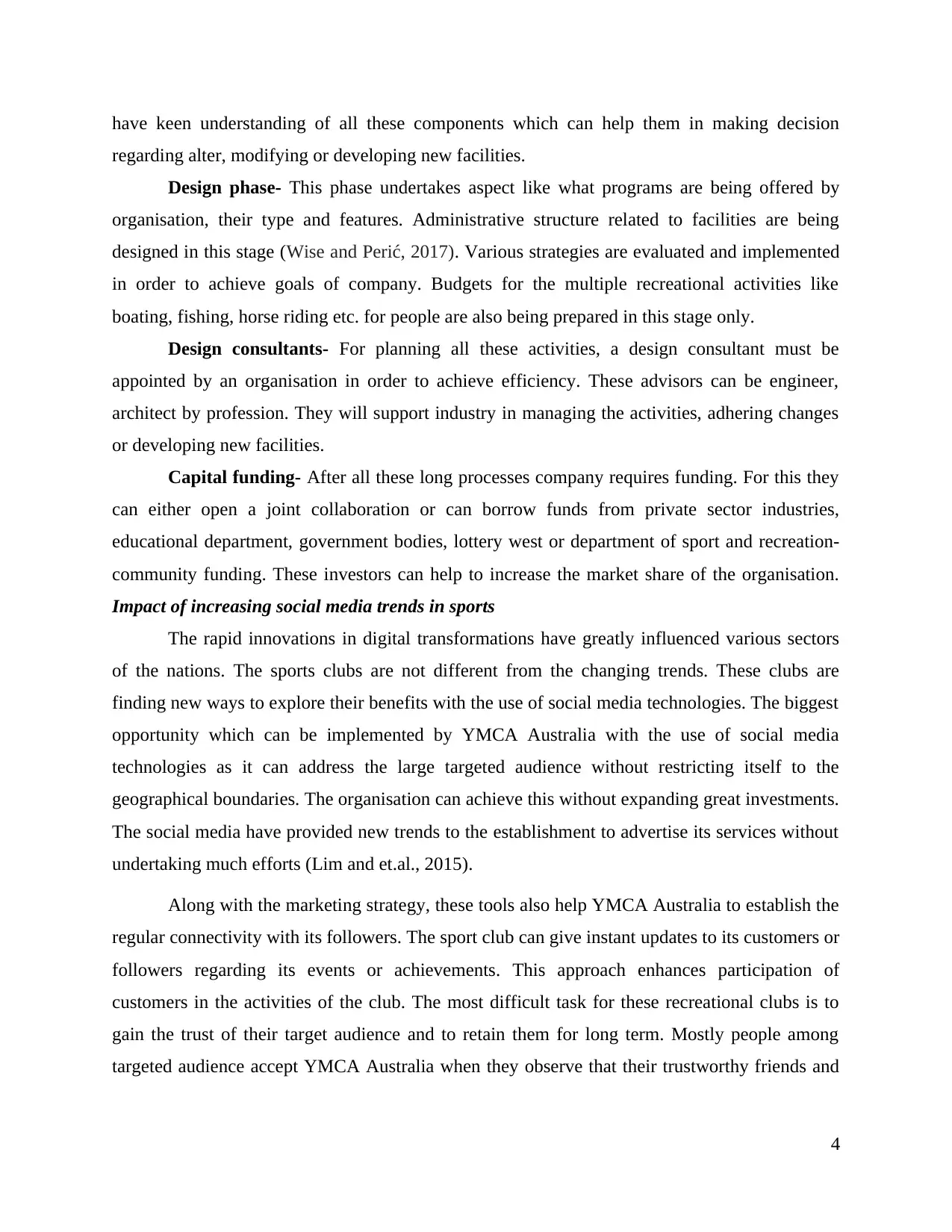
have keen understanding of all these components which can help them in making decision
regarding alter, modifying or developing new facilities.
Design phase- This phase undertakes aspect like what programs are being offered by
organisation, their type and features. Administrative structure related to facilities are being
designed in this stage (Wise and Perić, 2017). Various strategies are evaluated and implemented
in order to achieve goals of company. Budgets for the multiple recreational activities like
boating, fishing, horse riding etc. for people are also being prepared in this stage only.
Design consultants- For planning all these activities, a design consultant must be
appointed by an organisation in order to achieve efficiency. These advisors can be engineer,
architect by profession. They will support industry in managing the activities, adhering changes
or developing new facilities.
Capital funding- After all these long processes company requires funding. For this they
can either open a joint collaboration or can borrow funds from private sector industries,
educational department, government bodies, lottery west or department of sport and recreation-
community funding. These investors can help to increase the market share of the organisation.
Impact of increasing social media trends in sports
The rapid innovations in digital transformations have greatly influenced various sectors
of the nations. The sports clubs are not different from the changing trends. These clubs are
finding new ways to explore their benefits with the use of social media technologies. The biggest
opportunity which can be implemented by YMCA Australia with the use of social media
technologies as it can address the large targeted audience without restricting itself to the
geographical boundaries. The organisation can achieve this without expanding great investments.
The social media have provided new trends to the establishment to advertise its services without
undertaking much efforts (Lim and et.al., 2015).
Along with the marketing strategy, these tools also help YMCA Australia to establish the
regular connectivity with its followers. The sport club can give instant updates to its customers or
followers regarding its events or achievements. This approach enhances participation of
customers in the activities of the club. The most difficult task for these recreational clubs is to
gain the trust of their target audience and to retain them for long term. Mostly people among
targeted audience accept YMCA Australia when they observe that their trustworthy friends and
4
regarding alter, modifying or developing new facilities.
Design phase- This phase undertakes aspect like what programs are being offered by
organisation, their type and features. Administrative structure related to facilities are being
designed in this stage (Wise and Perić, 2017). Various strategies are evaluated and implemented
in order to achieve goals of company. Budgets for the multiple recreational activities like
boating, fishing, horse riding etc. for people are also being prepared in this stage only.
Design consultants- For planning all these activities, a design consultant must be
appointed by an organisation in order to achieve efficiency. These advisors can be engineer,
architect by profession. They will support industry in managing the activities, adhering changes
or developing new facilities.
Capital funding- After all these long processes company requires funding. For this they
can either open a joint collaboration or can borrow funds from private sector industries,
educational department, government bodies, lottery west or department of sport and recreation-
community funding. These investors can help to increase the market share of the organisation.
Impact of increasing social media trends in sports
The rapid innovations in digital transformations have greatly influenced various sectors
of the nations. The sports clubs are not different from the changing trends. These clubs are
finding new ways to explore their benefits with the use of social media technologies. The biggest
opportunity which can be implemented by YMCA Australia with the use of social media
technologies as it can address the large targeted audience without restricting itself to the
geographical boundaries. The organisation can achieve this without expanding great investments.
The social media have provided new trends to the establishment to advertise its services without
undertaking much efforts (Lim and et.al., 2015).
Along with the marketing strategy, these tools also help YMCA Australia to establish the
regular connectivity with its followers. The sport club can give instant updates to its customers or
followers regarding its events or achievements. This approach enhances participation of
customers in the activities of the club. The most difficult task for these recreational clubs is to
gain the trust of their target audience and to retain them for long term. Mostly people among
targeted audience accept YMCA Australia when they observe that their trustworthy friends and
4
⊘ This is a preview!⊘
Do you want full access?
Subscribe today to unlock all pages.

Trusted by 1+ million students worldwide
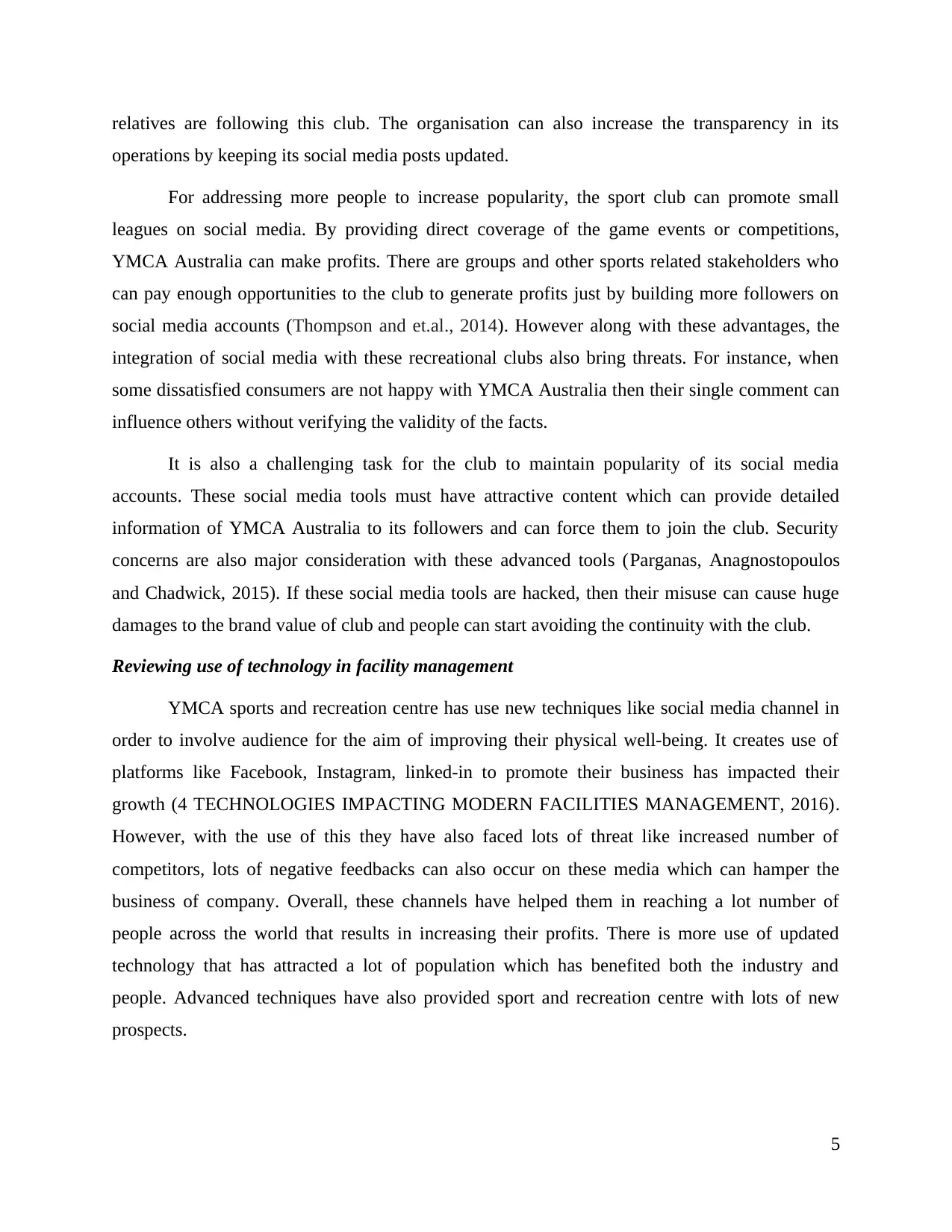
relatives are following this club. The organisation can also increase the transparency in its
operations by keeping its social media posts updated.
For addressing more people to increase popularity, the sport club can promote small
leagues on social media. By providing direct coverage of the game events or competitions,
YMCA Australia can make profits. There are groups and other sports related stakeholders who
can pay enough opportunities to the club to generate profits just by building more followers on
social media accounts (Thompson and et.al., 2014). However along with these advantages, the
integration of social media with these recreational clubs also bring threats. For instance, when
some dissatisfied consumers are not happy with YMCA Australia then their single comment can
influence others without verifying the validity of the facts.
It is also a challenging task for the club to maintain popularity of its social media
accounts. These social media tools must have attractive content which can provide detailed
information of YMCA Australia to its followers and can force them to join the club. Security
concerns are also major consideration with these advanced tools (Parganas, Anagnostopoulos
and Chadwick, 2015). If these social media tools are hacked, then their misuse can cause huge
damages to the brand value of club and people can start avoiding the continuity with the club.
Reviewing use of technology in facility management
YMCA sports and recreation centre has use new techniques like social media channel in
order to involve audience for the aim of improving their physical well-being. It creates use of
platforms like Facebook, Instagram, linked-in to promote their business has impacted their
growth (4 TECHNOLOGIES IMPACTING MODERN FACILITIES MANAGEMENT, 2016).
However, with the use of this they have also faced lots of threat like increased number of
competitors, lots of negative feedbacks can also occur on these media which can hamper the
business of company. Overall, these channels have helped them in reaching a lot number of
people across the world that results in increasing their profits. There is more use of updated
technology that has attracted a lot of population which has benefited both the industry and
people. Advanced techniques have also provided sport and recreation centre with lots of new
prospects.
5
operations by keeping its social media posts updated.
For addressing more people to increase popularity, the sport club can promote small
leagues on social media. By providing direct coverage of the game events or competitions,
YMCA Australia can make profits. There are groups and other sports related stakeholders who
can pay enough opportunities to the club to generate profits just by building more followers on
social media accounts (Thompson and et.al., 2014). However along with these advantages, the
integration of social media with these recreational clubs also bring threats. For instance, when
some dissatisfied consumers are not happy with YMCA Australia then their single comment can
influence others without verifying the validity of the facts.
It is also a challenging task for the club to maintain popularity of its social media
accounts. These social media tools must have attractive content which can provide detailed
information of YMCA Australia to its followers and can force them to join the club. Security
concerns are also major consideration with these advanced tools (Parganas, Anagnostopoulos
and Chadwick, 2015). If these social media tools are hacked, then their misuse can cause huge
damages to the brand value of club and people can start avoiding the continuity with the club.
Reviewing use of technology in facility management
YMCA sports and recreation centre has use new techniques like social media channel in
order to involve audience for the aim of improving their physical well-being. It creates use of
platforms like Facebook, Instagram, linked-in to promote their business has impacted their
growth (4 TECHNOLOGIES IMPACTING MODERN FACILITIES MANAGEMENT, 2016).
However, with the use of this they have also faced lots of threat like increased number of
competitors, lots of negative feedbacks can also occur on these media which can hamper the
business of company. Overall, these channels have helped them in reaching a lot number of
people across the world that results in increasing their profits. There is more use of updated
technology that has attracted a lot of population which has benefited both the industry and
people. Advanced techniques have also provided sport and recreation centre with lots of new
prospects.
5
Paraphrase This Document
Need a fresh take? Get an instant paraphrase of this document with our AI Paraphraser
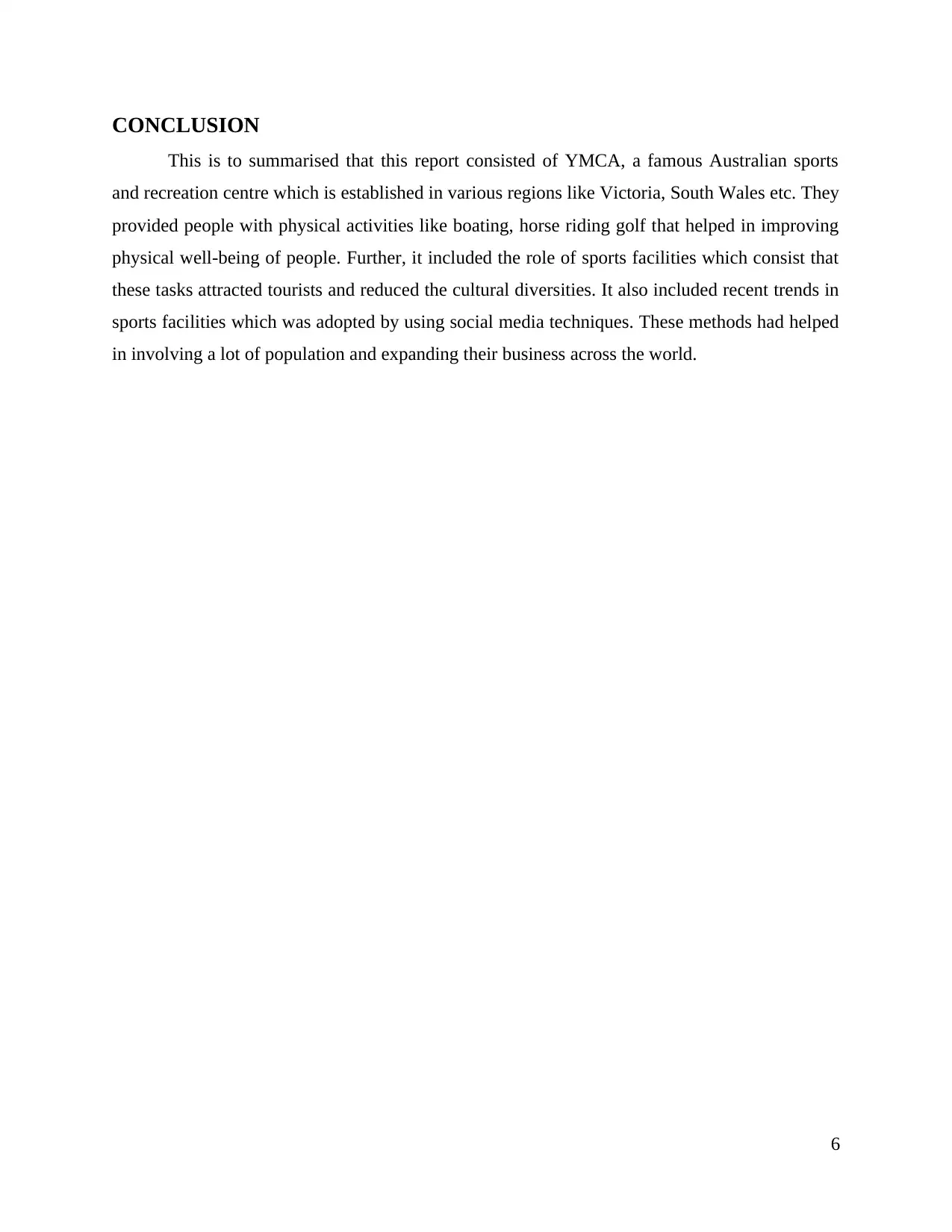
CONCLUSION
This is to summarised that this report consisted of YMCA, a famous Australian sports
and recreation centre which is established in various regions like Victoria, South Wales etc. They
provided people with physical activities like boating, horse riding golf that helped in improving
physical well-being of people. Further, it included the role of sports facilities which consist that
these tasks attracted tourists and reduced the cultural diversities. It also included recent trends in
sports facilities which was adopted by using social media techniques. These methods had helped
in involving a lot of population and expanding their business across the world.
6
This is to summarised that this report consisted of YMCA, a famous Australian sports
and recreation centre which is established in various regions like Victoria, South Wales etc. They
provided people with physical activities like boating, horse riding golf that helped in improving
physical well-being of people. Further, it included the role of sports facilities which consist that
these tasks attracted tourists and reduced the cultural diversities. It also included recent trends in
sports facilities which was adopted by using social media techniques. These methods had helped
in involving a lot of population and expanding their business across the world.
6
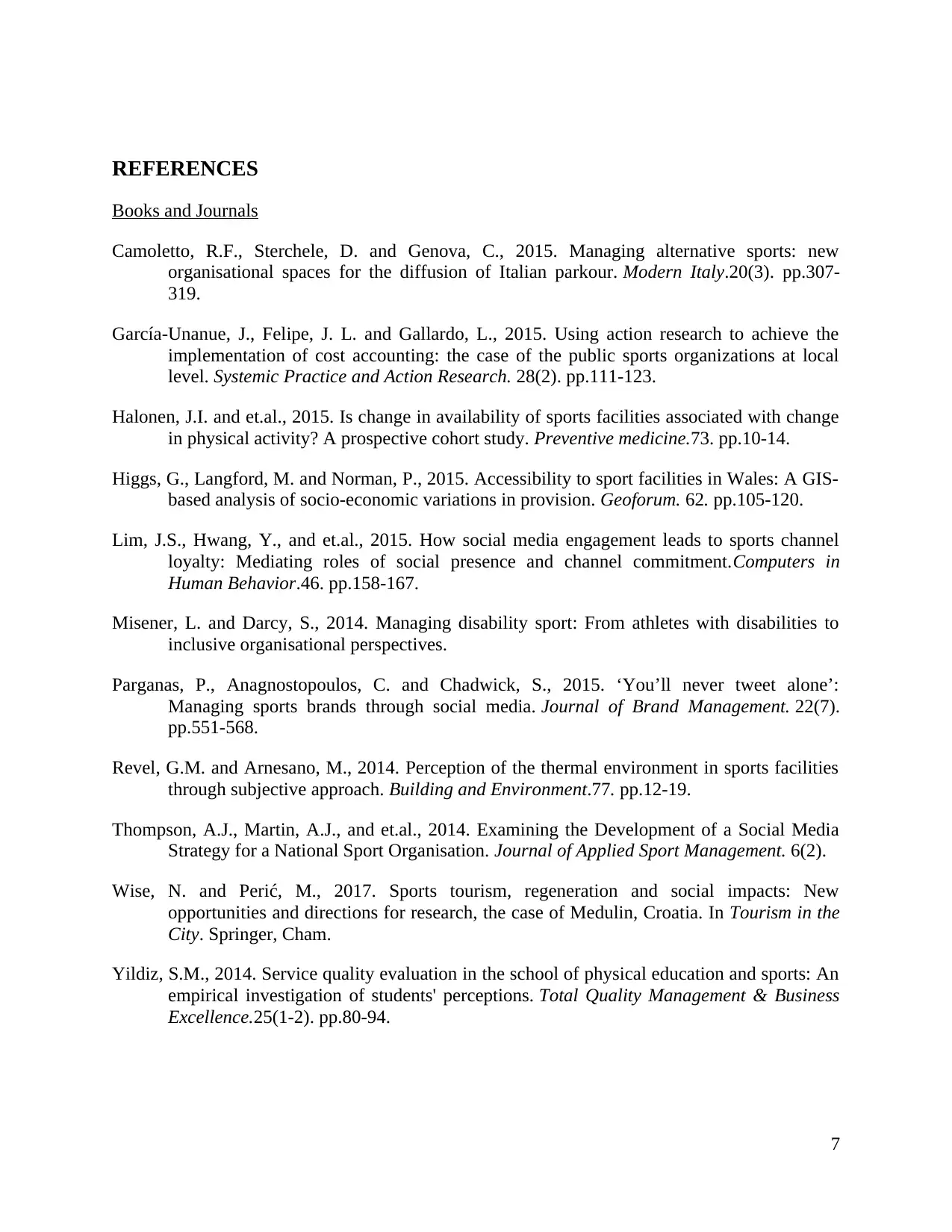
REFERENCES
Books and Journals
Camoletto, R.F., Sterchele, D. and Genova, C., 2015. Managing alternative sports: new
organisational spaces for the diffusion of Italian parkour. Modern Italy.20(3). pp.307-
319.
García-Unanue, J., Felipe, J. L. and Gallardo, L., 2015. Using action research to achieve the
implementation of cost accounting: the case of the public sports organizations at local
level. Systemic Practice and Action Research. 28(2). pp.111-123.
Halonen, J.I. and et.al., 2015. Is change in availability of sports facilities associated with change
in physical activity? A prospective cohort study. Preventive medicine.73. pp.10-14.
Higgs, G., Langford, M. and Norman, P., 2015. Accessibility to sport facilities in Wales: A GIS-
based analysis of socio-economic variations in provision. Geoforum. 62. pp.105-120.
Lim, J.S., Hwang, Y., and et.al., 2015. How social media engagement leads to sports channel
loyalty: Mediating roles of social presence and channel commitment.Computers in
Human Behavior.46. pp.158-167.
Misener, L. and Darcy, S., 2014. Managing disability sport: From athletes with disabilities to
inclusive organisational perspectives.
Parganas, P., Anagnostopoulos, C. and Chadwick, S., 2015. ‘You’ll never tweet alone’:
Managing sports brands through social media. Journal of Brand Management. 22(7).
pp.551-568.
Revel, G.M. and Arnesano, M., 2014. Perception of the thermal environment in sports facilities
through subjective approach. Building and Environment.77. pp.12-19.
Thompson, A.J., Martin, A.J., and et.al., 2014. Examining the Development of a Social Media
Strategy for a National Sport Organisation. Journal of Applied Sport Management. 6(2).
Wise, N. and Perić, M., 2017. Sports tourism, regeneration and social impacts: New
opportunities and directions for research, the case of Medulin, Croatia. In Tourism in the
City. Springer, Cham.
Yildiz, S.M., 2014. Service quality evaluation in the school of physical education and sports: An
empirical investigation of students' perceptions. Total Quality Management & Business
Excellence.25(1-2). pp.80-94.
7
Books and Journals
Camoletto, R.F., Sterchele, D. and Genova, C., 2015. Managing alternative sports: new
organisational spaces for the diffusion of Italian parkour. Modern Italy.20(3). pp.307-
319.
García-Unanue, J., Felipe, J. L. and Gallardo, L., 2015. Using action research to achieve the
implementation of cost accounting: the case of the public sports organizations at local
level. Systemic Practice and Action Research. 28(2). pp.111-123.
Halonen, J.I. and et.al., 2015. Is change in availability of sports facilities associated with change
in physical activity? A prospective cohort study. Preventive medicine.73. pp.10-14.
Higgs, G., Langford, M. and Norman, P., 2015. Accessibility to sport facilities in Wales: A GIS-
based analysis of socio-economic variations in provision. Geoforum. 62. pp.105-120.
Lim, J.S., Hwang, Y., and et.al., 2015. How social media engagement leads to sports channel
loyalty: Mediating roles of social presence and channel commitment.Computers in
Human Behavior.46. pp.158-167.
Misener, L. and Darcy, S., 2014. Managing disability sport: From athletes with disabilities to
inclusive organisational perspectives.
Parganas, P., Anagnostopoulos, C. and Chadwick, S., 2015. ‘You’ll never tweet alone’:
Managing sports brands through social media. Journal of Brand Management. 22(7).
pp.551-568.
Revel, G.M. and Arnesano, M., 2014. Perception of the thermal environment in sports facilities
through subjective approach. Building and Environment.77. pp.12-19.
Thompson, A.J., Martin, A.J., and et.al., 2014. Examining the Development of a Social Media
Strategy for a National Sport Organisation. Journal of Applied Sport Management. 6(2).
Wise, N. and Perić, M., 2017. Sports tourism, regeneration and social impacts: New
opportunities and directions for research, the case of Medulin, Croatia. In Tourism in the
City. Springer, Cham.
Yildiz, S.M., 2014. Service quality evaluation in the school of physical education and sports: An
empirical investigation of students' perceptions. Total Quality Management & Business
Excellence.25(1-2). pp.80-94.
7
⊘ This is a preview!⊘
Do you want full access?
Subscribe today to unlock all pages.

Trusted by 1+ million students worldwide
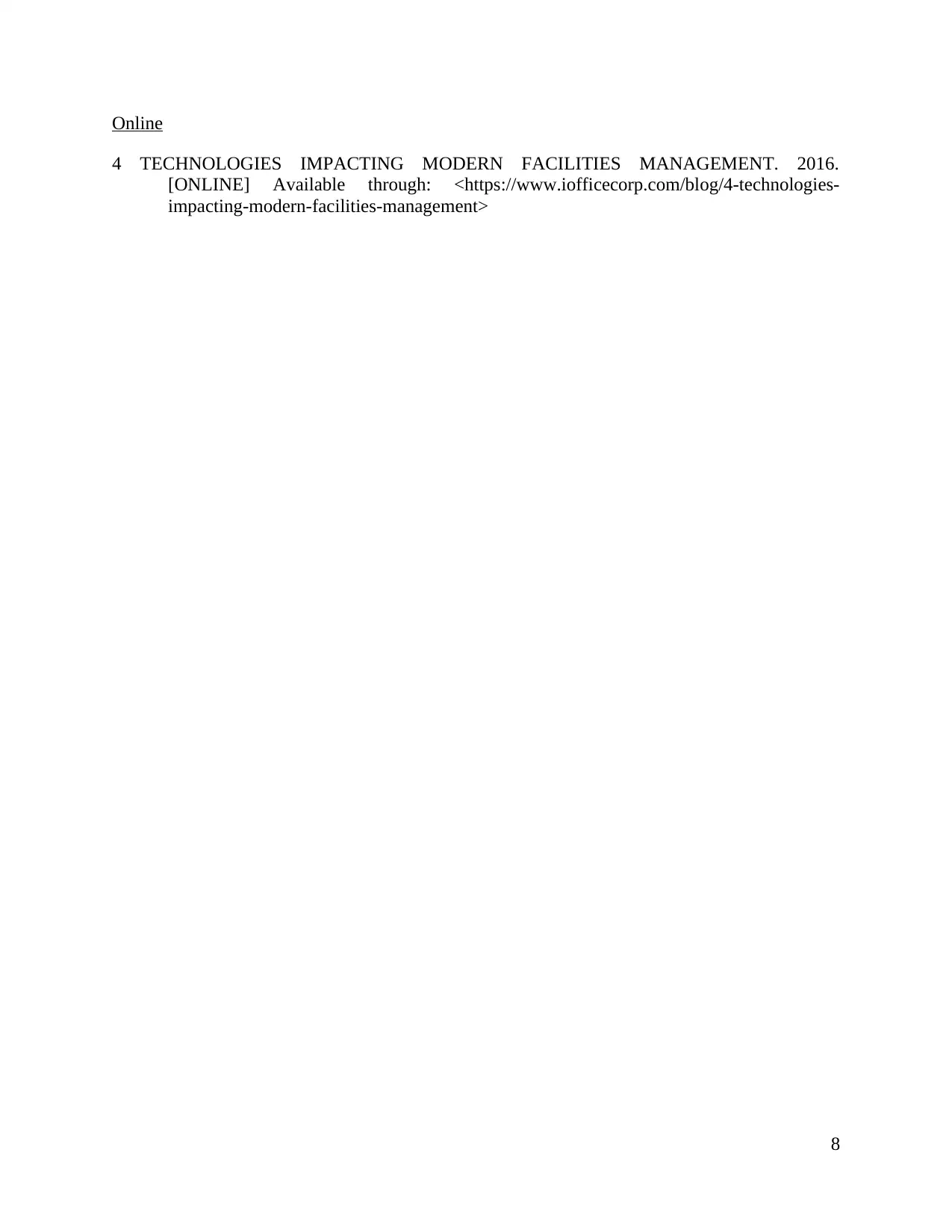
Online
4 TECHNOLOGIES IMPACTING MODERN FACILITIES MANAGEMENT. 2016.
[ONLINE] Available through: <https://www.iofficecorp.com/blog/4-technologies-
impacting-modern-facilities-management>
8
4 TECHNOLOGIES IMPACTING MODERN FACILITIES MANAGEMENT. 2016.
[ONLINE] Available through: <https://www.iofficecorp.com/blog/4-technologies-
impacting-modern-facilities-management>
8
1 out of 10
Related Documents
Your All-in-One AI-Powered Toolkit for Academic Success.
+13062052269
info@desklib.com
Available 24*7 on WhatsApp / Email
![[object Object]](/_next/static/media/star-bottom.7253800d.svg)
Unlock your academic potential
Copyright © 2020–2025 A2Z Services. All Rights Reserved. Developed and managed by ZUCOL.





